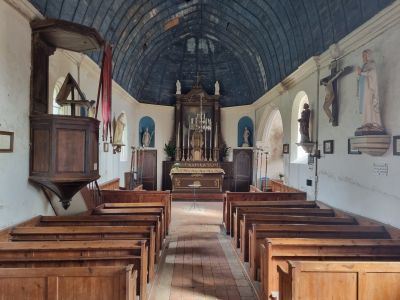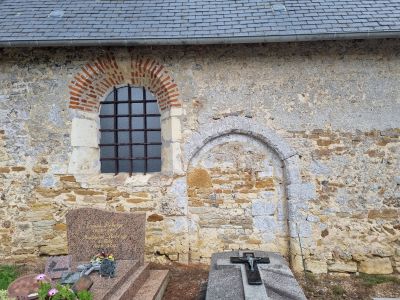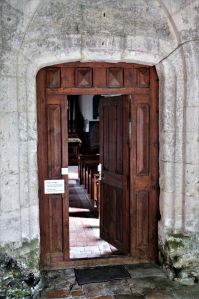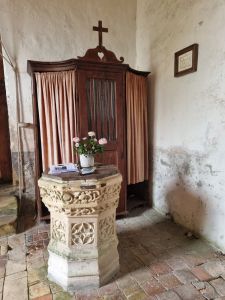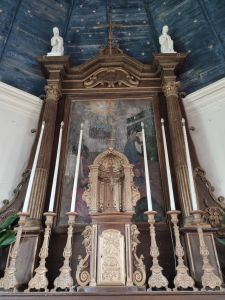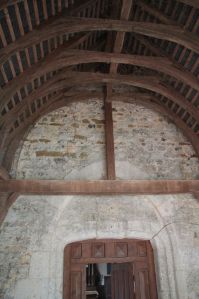Church | Xe ou XIe - XVIe | Renaissance | Catholic Church


Map
Opening hours
01 January - 31 December
Mon 9.30 - 18.00
Tue 9.30 - 18.00
Wed 9.30 - 18.00
Thu 9.30 - 18.00
Fri 9.30 - 18.00
Sat 9.30 - 18.00
Sun 9.30 - 18.00
Description
At the heart of the Vieux-Bourg cemetery stands the church of Our Lady of Brambles. Its name comes from the fact that it was once surrounded by brambles.
The church is typical of the churches in the Pays d'Auge. Most of them date back to the Romanesque period, as can be seen here in the elements of the south wall, such as the walled door, the semicircular openings and the fishbones.
The churches in this area are modest in size and have a simple plan, consisting of a single nave and a choir.
Late additions complete the ensemble. In the 16th century, the church of Vieux-Bourg was enriched with a porch and a chapel in the Gothic style as indicated by its ogival opening. Many of these churches were fitted with buttresses at the same time and had their openings modified.
Although the churches of the Auge region have many points in common, they are all different because of the history of the village and its evolution.
As you enter this country church, don't forget to look up to discover the vaulted stave ceiling painted with a starry sky and to appreciate the items on display, witnesses to the life of the village, such as the 15th century baptismal font and the church's altarpiece.
Discover the leaflet produced by the ASPVB with a QR code for a virtual visit of the building, by clicking here...
Translated with www.DeepL.com/Translator (free version)
Photos
Remarkable elements
Fishbone wall
The south wall is the oldest part of the church. It can be recognised by its fishbone pattern, in which the bricks, or flat stones, are inclined and change direction with each row.
This technique, using local materials, gave the walls greater stability at lower cost. Although fishbone brickwork is known from Roman times, it was widely used in church construction between the Carolingian and Romanesque periods.
Caquetoire
Most caquetoires date from the 15th or 16th century and are attached to Romanesque churches. This sheltered space was used by parishioners to meet up and exchange news, hence the name derived from the verb caqueter, which means ‘to gossip indiscriminately’.
They are found mainly in villages, particularly in central France, but also in Normandy.
Baptismal font
Dating from the 15th century, these baptismal fonts are protected as Historic Monuments.
They are richly decorated with foliage and bunches of grapes. A child's head is also carved on the base.
The octagonal base is decorated with geometric shapes.
Torch of the Brotherhood of Charity of Vieux-Bourg
The Confraternities of Charity are associations of parishioners who attend funerals on a voluntary basis, accompanying the families and the celebrant.
They are recognisable by their banners, their chaperon (decorated piece of stole), their tintenelles (bells) and their torchères, used to carry the candles.
Altarpiece
The 18th-century polychrome altarpiece will soon be restored, and research has already been carried out into the various layers of polychromy.
The canvas, dated 177, depicts a relatively rare scene: the birth of the Virgin.
Stained glass
A campaign to restore the stained glass windows is currently underway, and funds are being raised to support the commune and the association.
The stained glass windows are the work of master glassmakers from the Gouty workshop in Cormeilles.
The first to be installed was in the chapel of the Virgin. A special feature of the exterior has been preserved: its wooden infill.
Other stained glass windows will be added shortly, illustrating the Baptism of Jesus and the Wedding at Cana.
Saint Erme
This polychrome plaster statue recalls the presence, below the church, of a miraculous fountain believed to cure eye ailments.
Pilgrims soak a cloth in the spring, dab it over their eyes and then light a candle in front of the statue. The cloth is then hung on the hedge. Many of the cloths can still be seen there today.



